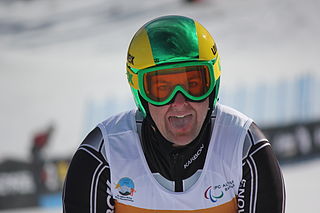
Paralympic alpine skiing is an adaptation of alpine skiing for athletes with a disability. The sport evolved from the efforts of disabled veterans in Germany and Austria during and after the Second World War. The sport is governed by the International Paralympic Committee Sports Committee. The primary equipment used includes outrigger skis, sit-skis, and mono-skis. Para-alpine skiing disciplines include the downhill, super-G, giant slalom, slalom, super combined, and snowboard.

The 1984 Winter Paralympics, then known as The Third World Winter Games for the Disabled, were held in Innsbruck, Austria. The games took place from the 15 until 21 January. Present at these games were 419 athletes from 21 countries, Spain and the Netherlands competing for the first time in the Winter Paralympics, competing in 107 events across 3 sports. The inclusion of Les Austres and Cerebral palsy impairment groups contributing to the distinct increase in athlete participation with the total number of athletes jumping from 229 at Geilo, Norway in 1980.

Australia sent a delegation to compete at the 1988 Winter Paralympics in Innsbruck, Austria, which was held between 17–24 January 1988. This marked the nation's fourth appearance at the Winter Paralympics. The delegation sent a group of five alpine skiers as they wouldn't get a medal in these games.

The 1994 Winter Paralympics were held in Lillehammer, Norway. Australia sent six male skiers, who won three gold, two silver and four bronze medals. Australia, at the time, achieved their best ever performance at a Winter Paralympics, finishing 5th overall in the alpine skiing competition, 9th in the medal standings, and 11th in the total medal count out of 31 nations.

LW10 is a para-alpine and para-Nordic sit-skiing classification for skiers who cannot sit up without support. For international skiing competitions, classification is conducted by IPC Alpine Skiing and IPC Nordic Skiing, while national federations such as Alpine Canada handle classification for domestic competitions.

LW1 is a para-alpine standing skiing classification for people with severe lower extreme disabilities in both extremities. It includes both skiers with amputations and cerebral palsy. International classification is done through IPC Alpine Skiing, and national classification through local national sport federations. LW1 classified skiers use outriggers, and two skis or one ski with a prosthesis. Other equipment is used during training such as ski-tips, ski-bras, and short skis.

LW2 is a para-alpine and para-Nordic standing ski sport class defined by the International Paralympic Committee (IPC). Competitors in this class have severe disability in a lower limb, which may be a result of an amputation, or arthrodesis in the leg and hip. Depending on the type of skiing, the international classification process for LW2 skiers is handled by the IPC Alpine Skiing Technical Committee and IPC Nordic Skiing Technical Committee. National sport federations handle classification on the lower levels.
LW3 is a para-alpine and para-Nordic standing skiing sport class defined by the International Paralympic Committee (IPC) for skiers with a disability affecting both legs, with double below knee amputation or a combined strength total for both legs of 60, with 80 as the baseline for people without disabilities. For international skiing competitions, classification is done through IPC Alpine Skiing or IPC Nordic Skiing. The classification has two subclasses for para-alpine skiing: LW3.1 which is for people with double below the knee amputations or similar disabilities, and LW3.2 which is for people with cerebral palsy that involves moderate athetoid, moderate ataxic impairment or slight diplegic involvement.
LW4 is a para-alpine and para-Nordic standing skiing sport class defined by the International Paralympic Committee (IPC) for skiers who may have a disability in one lower extremity, which may be a result of a leg amputation below the knee, knee arthrodesis or a hip arthrodesis. For international skiing competitions, classification is done through IPC Alpine Skiing or IPC Nordic Skiing. A national federation such as Alpine Canada handles classification for domestic competitions.
LW9 is a para-alpine and para-Nordic standing skiing sport class, a classification defined by the International Paralympic Committee (IPC) for people with upper and lower limb function problems, and includes cerebral palsy skiers classified CP5, CP6 and CP7, along with people with hemiplegia or amputations. For international skiing competitions, classification is done through IPC Alpine Skiing or IPC Nordic Skiing. A national federation such as Alpine Canada handles classification for domestic competitions. This classification is separated into two subclasses including LW9.1 and LW9.2.

The United States competed at the 1988 Winter Paralympics in Innsbruck, Austria. 45 competitors from the United States won 7 gold medals, 17 silver medal and 6 bronze medal and finished 6th in the medal table.

Switzerland competed at the 1988 Winter Paralympics in Innsbruck, Austria. 32 competitors from Switzerland won 23 medals including 8 gold, 7 silver and 8 bronze and finished 5th in the medal table.
Sarah Billmeier is an American para-alpine skier. She represented the United States in alpine skiing at the 1992, 1994, 1998 and 2002 Winter Paralympics. In total she won seven gold medals, five silver medals and one bronze medal.
David Jamison is an American para-alpine skier. He represented the United States at the 1984 Winter Paralympics and at the 1988 Winter Paralympics in alpine skiing.
Martha Hill is an American para-alpine skier. She represented the United States at the 1984 Winter Paralympics and at the 1988 Winter Paralympics in alpine skiing.
Lynda Chyzyk is a Canadian para-alpine skier. She represented Canada at the 1984 Winter Paralympics and at the 1988 Winter Paralympics. In total she won one gold medal, one silver medal and two bronze medals.
Roni Sasaki is an American para-alpine skier. She represented the United States at the 1992 Winter Paralympics in alpine skiing. She was born with one leg and she competed in LW2-classification events.
Danja Haslacher is an Austrian alpine skier who won five gold medals and one bronze medal at the Paralympic Games between 1998 and 2006. She also won the 2004 IPC Alpine Skiing World Championships super-G LW2 event.
Nadine Laurent is a French Paralympic alpine skier. She won a silver and a bronze medal at the 1992 Winter Paralympic Games in Albertville.
Nicola Lechner is an Austrian Paralympic alpine skier. She represented Austria in Paralympic Alpine skiing at the 1998 Paralympic Winter Games in Nagano, and 2002 Paralympic Winter Games in Salt Lake City. She won a total of five medals: three silver medals and two bronze medals.






